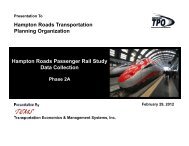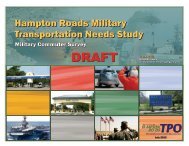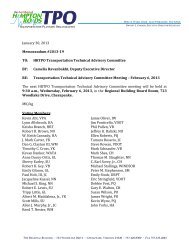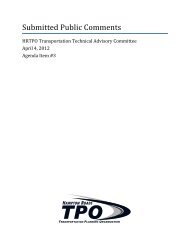Hampton Roads Regional Bridge Study
Hampton Roads Regional Bridge Study
Hampton Roads Regional Bridge Study
You also want an ePaper? Increase the reach of your titles
YUMPU automatically turns print PDFs into web optimized ePapers that Google loves.
REGIONAL BRIDGE SUMMARY 7<br />
BRIDGES BY LENGTH/AREA<br />
Although the number of bridges in <strong>Hampton</strong> <strong>Roads</strong> is low<br />
compared to other metropolitan areas, bridges in <strong>Hampton</strong> <strong>Roads</strong><br />
are typically much longer than those in other areas. In fact,<br />
among the 35 metropolitan areas in the United States with<br />
populations between one and three million people, <strong>Hampton</strong><br />
<strong>Roads</strong> has the second longest average bridge length behind only<br />
New Orleans.<br />
The 1,223 bridges in <strong>Hampton</strong> <strong>Roads</strong> span 565,000 feet, or an<br />
average of 460 feet for each bridge. At over 107 miles, if bridges<br />
in <strong>Hampton</strong> <strong>Roads</strong> were laid end to end, they would stretch all<br />
the way from the Virginia Beach Oceanfront to the west side of<br />
Richmond.<br />
Total Deck Area of <strong>Bridge</strong>s (Square Meters)<br />
7,000,000<br />
6,000,000<br />
5,000,000<br />
4,000,000<br />
3,000,000<br />
2,000,000<br />
1,000,000<br />
0<br />
Due to these long bridges, the total area of bridges in <strong>Hampton</strong><br />
<strong>Roads</strong> is high. The total deck area of bridges in <strong>Hampton</strong> <strong>Roads</strong><br />
is 28,227,000 square feet, or 2,622,000 square meters, as of<br />
August 2012. This ranks <strong>Hampton</strong> <strong>Roads</strong> 8th highest among the<br />
35 comparable metropolitan areas (Figure 5). Since bridge<br />
maintenance costs are significantly higher than typical roadway<br />
maintenance costs, the high total bridge area compared to other<br />
metropolitan areas means more funding is needed in <strong>Hampton</strong><br />
<strong>Roads</strong> to maintain these structures.<br />
FIGURE 5 – TOTAL BRIDGE AREA IN COMPARABLE METROPOLITAN AREAS<br />
Source: HRTPO analysis of VDOT and FHWA data. Data for <strong>Hampton</strong> <strong>Roads</strong> bridges as of August 2012, other areas as of 2011.<br />
300<br />
250<br />
BRIDGES BY AGE<br />
Aging infrastructure is a concern throughout the United States,<br />
whether it is power grids, dams, drinking water systems, or<br />
highways. <strong>Bridge</strong>s are no exception – the median bridge age in<br />
the United States is 40 years as of 2011, and nearly one out of<br />
every three bridges in the country is more than 50 years old. In<br />
Virginia, the median bridge age is 41 years according to federal<br />
data, slightly higher than the national figure.<br />
<strong>Bridge</strong>s by Year Built<br />
200<br />
150<br />
100<br />
50<br />
0<br />
< 1930 1930 -<br />
1939<br />
1940 -<br />
1949<br />
1950 -<br />
1959<br />
1960 -<br />
1969<br />
1970 -<br />
1979<br />
1980 -<br />
1989<br />
1990 -<br />
1999<br />
2000+<br />
FIGURE 6 – BRIDGES IN HAMPTON ROADS BY YEAR BUILT<br />
Source: HRTPO analysis of VDOT and FHWA data. Data for <strong>Hampton</strong> <strong>Roads</strong> bridges as of August 2012.<br />
HAMPTON James City/Williamsburg/York ROADS REGIONAL Transportation BRIDGE STUDY <strong>Study</strong>












